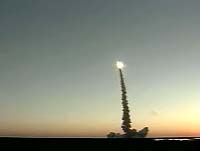|


Living In The Space Age

picture perfect in a cloudless sky |
by Larry Klaes
Los Angeles - Feb 06, 2003
When one contemplates the tragic loss of the
Space Shuttle Columbia and its crew of seven astronauts, it is often hard
for many of us to separate our emotions from the reasons why we send human
beings into space and why those people willingly accept these daring and
dangerous missions into a realm that can quickly end life from only a few
missteps.
The Space Shuttle Columbia Mission STS-107 was a case in point. Outside
of the fact that the first Israeli astronaut was on this flight, the
general public knew or cared little of what the mission objectives were.
Most media coverage was brief and often buried amidst unrelated news.
This Shuttle would not even be docking with the International Space
Station (ISS) Alpha. Instead it would "simply" circle our blue globe for
sixteen days. The astronauts would conduct over eighty different
experiments designed to compliment the work being done on the ISS.
The important fact is that this mission's experiments did relate
directly to our daily lives here on Earth. The researchers studied the
major functions of the human body in the purer microgravity environment as
it affects the brain, heart, lungs, blood vessels, and the nervous and
immune systems.
They watched how fire works in space. Earth's ozone layer and our
planet's climate were examined for clues to how different environments
interact with each other.
Is this the emotional equivalent of landing humans on Mars or
discovering extraterrestrial life? Not really, but it is good solid
research, the kind that has benefits way beyond some brief public
attention.
It is sometimes hard to see what good such things can do for us in our
hectic, busy lives, but the space program is full of examples where
designing and testing devices for space travel have led to major
improvements for our society.
One area we are all familiar with to various degrees is computers. In
the early days of these analytical machines, they tended to be the size of
large rooms and used hot, expensive vacuum tubes that frequently failed
and had to be replaced.
Computers were the logical systems of choice when the Space Age arrived
with its complex spacecraft and rockets. However, to build a rocket
booster that could lift those room-size monsters was both prohibitive and
impractical. Engineers and scientists had to find a way to shrink them
down to fit in the very confined places aboard a space vessel.
Thanks in large part to this need from the Space Age, we now have
sophisticated computers that can be held in the palm of your hand with
more power than every computer built before the advent of the first space
launches.
Another field advanced by space is what the STS-107 crew largely
focused on: Medicine. Many past space developments, some not even related
to the medical field, have made major contributions to this science.
One prime example is angioplasty. The DymerTM 200+ excimer angioplasty
laser system was first used for studying atmospheric turbulence from
satellites. It was later modified to help remove fatty buildup blocking
arteries that could lead to heart attacks.
The miniaturization that worked so well for computers also applies to
medicine. Thanks to engineers who created small measuring instruments
including tubes, valves, and pumps, these same devices have been used to
perform such tasks as assisting weakened hearts in pushing blood through
the body. This research is part of NASA's Programmable Implantable
Medication System (PIMS).
The technology made to enhance images of the lunar surface during the
Apollo program now allows doctors to view inside the human body without
needing invasive and potentially dangerous surgeries.
A device made for Apollo astronauts to drive the Lunar Rover with one
hand led to a similar technology called the Unistik Controller for helping
quadriplegics get around with relative ease in their wheelchairs,
certainly making their daily lives easier.
Not all benefits come from manned space missions. Our robot satellites
and space probes have greatly contributed to our expanding knowledge since
Sputnik 1 entered Earth orbit in October of 1957.
Imagine how limited our weather forecasting would be without
meteorology satellites. Thousands of lives have been saved from oncoming
hurricanes over the decades because electronic eyes in space monitored the
paths of those devastating storms.
This vital information allows authorities to warn residents in the way
of hurricanes to reach safety in time. Other types of Earth monitoring
craft have kept track of plant growth to improve our understanding of the
environment and watch foreign military actions to guard against sneak
attacks.
Communications satellites have allowed us to talk to anyone anywhere
across the globe at the speed of light. Watching television broadcasts and
receiving cell phone calls and e-mails from even remote places are routine
occurrences, thanks to these tireless machines high above us.
I hope these examples have helped to create a better understanding of
why people like the astronauts of the Space Shuttle Columbia and the many
thousands of others who work in the aerospace industries have dedicated
their lives - in certain instances to the fullest extent - to space
exploration and development.
They weren't doing it for some esoteric, abstract goal; they were
playing truly important parts to improve all of our lives physically,
intellectually, and culturally.
The next time you hear about a space mission being launched, know that
it is yet another piece of our lives and our future being dedicated by
your fellow human beings who see the true value of space exploration for
us all.
Some information gathered might seem abstract, but it may have
significant uses we cannot even comprehend at present. As English
physicist Michael Faraday once said when asked of the possible use for one
of his inventions, "What use is a newborn baby?" Like a newly born infant,
space science is our future.
|
![]()